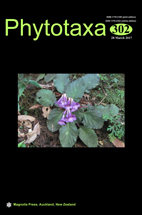Abstract
The process of anthesis of Sipaneopsis is unique within the Rubiaceae, and is here described and illustrated in detail for the first time. During the initial stage of anthesis the flowers are small, with the corolla lobes already open and erect before tube elongation, and the corolla lobe basal appendages are appressed against each other, forming a convex structure at the corolla mouth obstructing the entrance of visitors and pollinators. At the final stage of anthesis, the corolla lobes reflex and become perpendicular to the tube, and their basal appendages become erect, not touching each other, allowing visitors and pollinators to access the corolla tube and the nectar disk. Neobertiera and Sipaneopsis are unique within the tribe Sipaneeae in having indehiscent dry fruits and recent molecular phylogenies positioned them as sister taxa. Sipaneopsis is distinguished from Neobertiera in having flowers consistently homostylous (vs. distylous or rarely tristylous in Neobertiera), stamens inserted at the middle of the corolla tube (vs. at variable positions), and five triangular appendages at the base of each corolla lobe (vs. corolla lobes thickened at base, without appendages). The differences in flower morphology and process of anthesis between the two genera (which most likely influence their different pollination syndromes) provide an important set of significant taxonomic and diagnostic characters that can be used to distinguish them.

